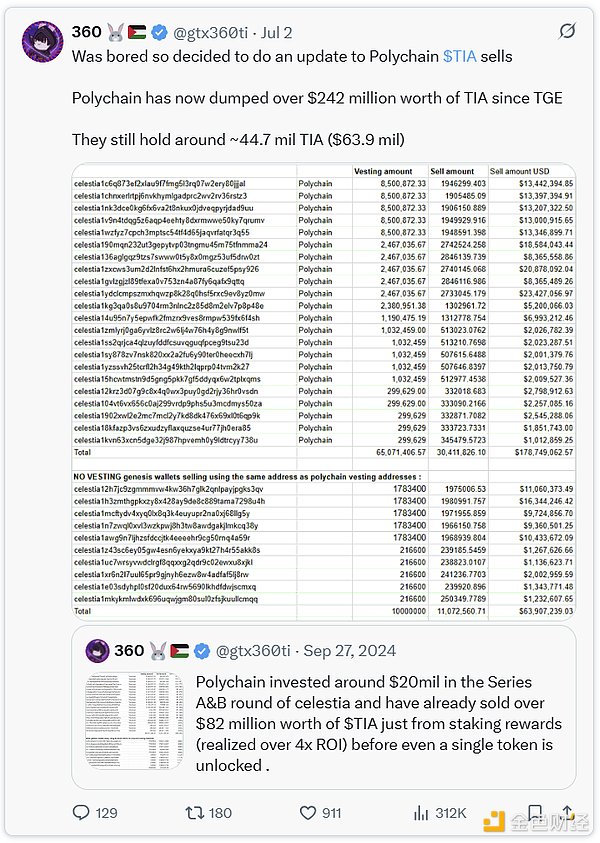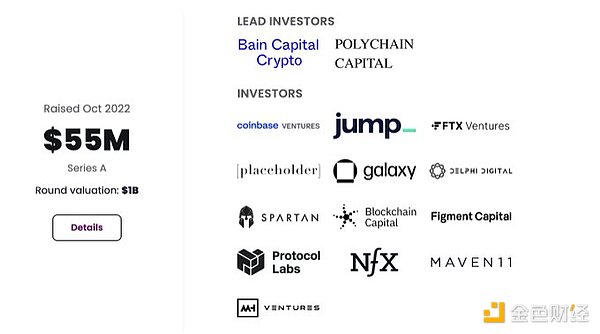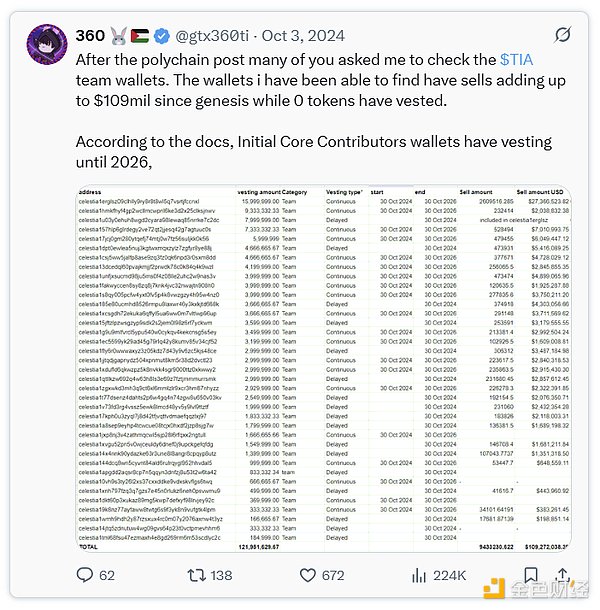Technological innovation is completely unrelated to token prices.
Written by: Pavel Paramonov, Founder of Hazeflow
Translated by: xiaozou, Jinse Finance
This article analyzes the recent sell-off event involving Celestia and Polychain—Polychain sold off $242 million worth of TIA. I believe this is both a good and a bad thing, and this article will delve into the reasons behind it and the lessons we can learn.

1. Do you expect investors not to make money?
Many people (including excellent researchers) have described this as a predatory and uncertain act by Polychain. How could a company regarded as a top-tier fund sell such a large position on the open market to impact the token price?
First of all, Polychain is a venture capital fund, and its duty is to profit from assets acquired during illiquid periods (I can't believe I need to explain this).
Polychain not only took on the risk of investing in Celestia at an early stage but also bet on concepts like the "external data availability layer," which were entirely new at the time. This idea was quite ahead of its time, and many people did not believe in it (especially those in the "Ethereum camp").
Imagine if someone discovered Spotify in 2008 and believed that everyone would listen to music through streaming services rather than CDs and MP3 players; that person would surely be considered crazy. This is the financing situation when you are not only a newcomer in the industry but also trying to carve out a new market in data availability throughput.
Polychain's duty is to take risks and earn returns, just like everyone else. Founders take on the risk of their company potentially failing, and ordinary people take on specific risks when making choices every day.
We are all making choices and taking risks; the only difference is the nature and scale of those risks.
Polychain is not the only investor; there are several other venture capital funds involved.

Interestingly, no one blames them because their trading data is harder to track.
But Polychain's sell-off alone is not enough to cause such a drastic price collapse. It must be pointed out that blaming only Polychain is unfair for the following reasons:
- Their duty is to take risks and make money, and they do it quite well.
- They are not the only sellers; other investors are also taking action.
Are these operations beneficial to investors? Of course.
Are these operations ethical for the community? You know the answer.

2. Do you expect the team not to make money?
Well, you might actually think so. There is a serious profitability issue in the crypto space: most protocols are not profitable, and they do not consider profitability at all. According to data from DefiLlama, Celestia currently earns about $200 per day (equivalent to the daily salary of a senior software engineer in Eastern Europe) while distributing about $570,000 in token incentives.

This is just the on-chain profit and loss data for the team; we know nothing about their off-chain profit and loss, but I believe the operational costs for such a large team are also quite high. Nowadays, there are indeed some KOLs seriously claiming, "Web3 protocols should be profitable, and companies should make money." Are we really taking this viewpoint seriously? Are we crazy?
Yes, we are indeed crazy, but the core issue is not the business model. The key is that the team views token sales as profit and builds a business model around this without ever considering the consequences. If token sales equal the business model, then why bother considering the business model and cash flow? Right? But the problem is that investors' money is not infinite, and tokens are not either.
Meanwhile, venture capital is inherently a bet on startups with huge potential for success. Many companies are not profitable, but they may offer something sufficiently revolutionary or interesting to attract others to explore and develop the idea.
In any case, you wouldn't expect the core team to never sell, would you? The fact is: when your protocol is not making money, you have to find funds elsewhere. The foundation has to sell some tokens to pay for infrastructure, salaries, and a host of other expenses.

At the very least, paying operational costs is one of the reasons for the sell-off that I am willing to believe. Of course, there may be other reasons and different perspectives: on one hand, their "dumping" harmed the community; on the other hand, they did build this protocol and create market hype, so perhaps they at least have the right to sell some tokens? Note that it's some, not all.
Ultimately, this reflects the issue of tokens/equity and is also why crypto venture capitalists are not fond of equity. Selling on the open market is more convenient and has a shorter time frame compared to private placements or waiting for exits.
3. Token economics is not the core issue; the token itself is
Clearly, investors are increasingly inclined to invest in tokens rather than equity. We are in the era of digital assets; isn't investing in digital assets a given?
But this trend is not as simple as it seems. Interestingly, many founders themselves realize that their products may not actually need tokens; they prefer to raise funds through equity. Nevertheless, they still face two major challenges:
- As I mentioned earlier, most crypto-native venture capitalists do not like equity (exits are more difficult).
- Equity valuations are usually lower than token valuations, and people always want to raise more money.
This situation not only creates a dilemma but also directly incentivizes teams to choose the token model. Token issuance can attract more investors because it provides a clear exit path in the public market, making it easier to raise funds. For the team, this means higher valuations and more development capital.
The core equity value of your company is not affected. You can retain 100% equity while raising a large amount of funds through these "artificial" tokens. This approach can also attract a broader group of investors specifically looking for token investment opportunities.
Unfortunately, in 99% of cases in the current environment, the token model makes retail investors poorer and venture capitalists richer. Or as Yash put it: infrastructure/governance tokens are just meme coins in suits.
However, when TIA launched, it did indeed bring substantial returns to retail investors—rising from $2 to $20. People were grateful to the team for making them wealthy and staked tokens to receive various airdrops. Yes, we had that moment; it was the fall of 2023…
When the price began to fall, people suddenly started spreading a lot of panic about Celestia: rumors of abnormal team behavior, predatory token economics, mocking on-chain revenue, and so on.
Identifying problems and pointing them out is a good thing, but if those who once praised Celestia now regard it as a "dumping ground" merely because of price trends, that would be truly unfortunate.
4. What conclusions can we draw from this?
Venture capital firms are almost never your friends. Their core business is making money, your core business is making money, and the core interest of venture capital LPs is also making money.
Do not blame them for selling off; their tokens are unlocked, and they have complete ownership of their assets, so they can dispose of them freely.
What should be criticized are those venture capitalists who sell off while promoting the token on Twitter: this is deceptive behavior and should never be tolerated.
Business models should not be designed solely around token sales. Either come up with a profitable model or maintain a non-profit status with top-notch technology—if done well, the market will pay.
Token economics is publicly transparent to everyone: if the team's tokens are unlocked, they certainly have the right to dispose of their assets. But if you are truly a staunch believer in the project, large-scale sell-offs are worth discussing.
Equity investment is not favored, and some token valuations are inflated and lack supporting metrics.
Teams should place a high emphasis on token economics design from the earliest stages; otherwise, they may pay a heavy price in the future.
Technological innovation is completely unrelated to token prices.
When the K-line rises, everyone is happy; when the K-line falls, the problems become apparent. If the same group of people who were praising the project suddenly start disparaging it, that is the real tragedy.
免责声明:本文章仅代表作者个人观点,不代表本平台的立场和观点。本文章仅供信息分享,不构成对任何人的任何投资建议。用户与作者之间的任何争议,与本平台无关。如网页中刊载的文章或图片涉及侵权,请提供相关的权利证明和身份证明发送邮件到support@aicoin.com,本平台相关工作人员将会进行核查。




